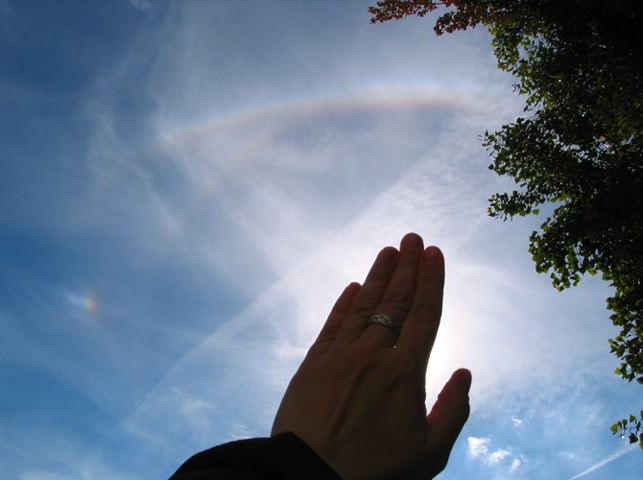| Lowitz Arc - Trier, Germany |
 |
|
||||||
| ||||||

Lowitz arc at Trier, Germany photographed by Eva Seidenfaden (Atmospheric optics site) on 30th September 2003 - solar elevation 37°. ©Eva Seidenfaden, shown with permission. The 22° halo region at 10 o'clock is brighter where the upper Lowitz arc overlaps it. Conversely the 22° halo region nearest the parhelion is dim. Both are indicative of a Lowitz arc. There is also a possible brightening of the Parry arc region where an upper arc would be tangent to it. Image 1 is unenhanced. In general, 'enhancing' can increases the ease of visibility of faint halos but rarely shows features not already visible on the original image. Always copy and safely archive originals for they are the most valuable. Image 2 has had levels adjusted to increase contrast. It was then gently unsharp masked. Image 3 is the result of an 'Emboss' operation applied to Image 2. The direction of the 'light' shining on the embossed image can be rotated to highlight particular suspected halos. Here the operation shows a possible upper Lowitz arc extending down to near the parhelion. The region near to the Parry arc has too many irregular clouds for the function to be useful. Embossing, like unsharp masking, should not be overdone and needs caution because both can produce artifacts. Image 4 is Image 2 overlaid with a HaloSim4 simulation using plate crystals with classical Lowitz orientations. Ordinary plates, singly oriented columns, Parry oriented columns and randomly oriented crystals generated the other arcs. Wisps of cloud often masquerade as arcs (especially it seems Lowitz arcs!) and several images of a display should be taken over some minutes to allow clouds to change. Eva Seidenfaden's images are here. A powerful technique is to reduce cloud effects by stacking several images. |
